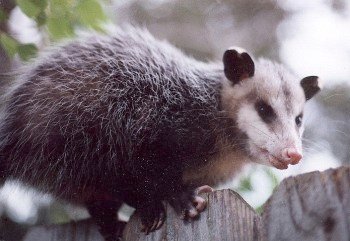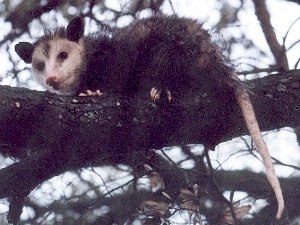Opossum
by Valerie (November 6, 2002)
|
There are not too many mammals that frequent our gardens and yard, as we live in an urban environment and have a relatively small yard. However, we have on many occasions hosted the nightly forages of opossums. They are nocturnal, but can often be found still hanging around after the sun comes up.
Opossums belong to a group of New World marsupials which includes about 65 species. Only the Virginia, or common, opossum occurs north of Mexico. Opossums do not hibernate, but may sleep a lot through cold weather. In their northernmost range, they often lose parts of ears or the tip of their tail to frostbite, as these have no fur and the opossum is not adapted to extremely cold temperatures. Although they look like big rats, they are really related to kangaroos, koalas and Tasmanian devils.
The only way we find the animals in our yard is when our dog alerts us to them. Opossums make very little noise and are not aggressive, preferring to be left alone. They eat just about everything, including snails, slugs, insects, small mammals, carrion, and, of course, pet food left outside. Although they are excellent climbers, they spend a lot of time on the ground searching for food. When startled, their first response is usually to climb a tree or fence to escape. Their feet are very well equipped for this, as their front paws have five very dexterous little toes. The rear feet have four clawed toes and an opposable "thumb" which does not have a claw. Besides their feet, the opossums have a prehensile tail which aids in maneuvering on branches and fences. They do not hang upside down by their tail, but will curl it around a branch or use it as a balance aid. The tail is furless and is covered with fine scale-like structures. It is often black at the base and white towards the tip. The fur of opossums is usually gray and grizzled, but can range from almost pure white to almost black. They are sometimes hunted for both their fur and their meat, but are said to be rather oily fare. Opossums have a constantly wet nose due to glands that secrete moisture. Their eyesight is not all that great but they have a good sense of smell and find most of their food through that sense.
Because opossums are not very fast animals (they can often be seen "waddling" along at a slow pace), they often have encounters with predators. Although opossums have more teeth (50) in their mouths than any other land mammal in North America, only the large canines are dangerous. Opossums will sometimes bite in self defense and can cause injury to a dog or cat. However, they transmit few diseases, and it is extremely rare for them to carry rabies. One reason might be that their body temperature is lower than most placental mammals. Another might be that, through the effects of evolution, they are more remotely related to other mammals.
The most well-known behavior of opossums is that of "playing dead." Supposedly this is an involuntary action, somewhat like going into shock. However, opossums that have done this are quite aware of things going on around them and will watch any potential danger, getting up and waddling away as soon as it is removed to a sufficient distance. They open their eyes, but if they still see danger, they will close them again. Also, when the opossums are playing dead, they will grasp onto branches, grass, or anything else they can if they are pulled or dragged. The classic position when playing dead is for them to curl their head back under themselves and grimace to expose their teeth. This looks quite convincing and they certainly don't look appetizing to me at the point (as if they ever did). Even with this defense mechanism, which might make a predator lose the "chase and kill" response, might make it really think that the opossum is dead and therefore not adequate fare, or might just confuse it, opossums are still very likely to fall prey to everything from dogs and coyotes to cars and humans. The average opossum lifespan in the wild is 1 - 2 years.
To make up for this high mortality rate, opossums breed quickly and efficiently. In fact, their method of bearing young is one of the most fascinating features about them. Unlike placental mammals, which retain their young internally while they develop, marsupials give birth to tiny, undeveloped infants that are more fetus than young animal. Opossums can start breeding before they are one year old and can produce 2 - 3 litters a year here in the South. The male opossum has a two-pronged, or bifurcated, penis, and when he ejaculates sperm, they swim in pairs. Before fertilization, they do separate. In keeping with the double theme, the female has two uteri. After a gestation period of only 13 days, the barely developed young, which are about the size of a honeybee and have only front legs at this point, must crawl into the furred pouch of the mother and fasten on to a teat. Although there can be 20 young born, there are only about 13 teats inside the pouch, and they might not all function. Once the baby opossum attaches to a teat, it swells to fill its mouth and help it hang on. By the time the young animals leave the pouch, only about 7 usually survive. The baby opossums spend additional time clinging to their mother's back after they outgrow the pouch, until they are able to fend for themselves.
Because opossums mate quickly and birth is a rather low-key affair with the young being so tiny, an amusing myth was created. The belief was that the male used his bifurcated penis to eject sperm into the female's nose (well, it was the right size and shape). She then sneezed the tiny babies into her pouch (she wasn't sneezing, she was licking the hair to make the babies journey to the teats easier). As anyone who has seen an opossum skull knows, their cranium is quite diminutive. There are large crests of bone which allow for muscle attachment, but the opossum does not have a lot of brain power compared to other mammals its size, such as raccoons or foxes. I've often been amused by the antics of opossums, which mainly occur because of their limited behavioral repertoire. One of the funniest is watching them on the back of our privacy fence. The limbs of overhanging trees come very close to the top of the fence and I've watched as a confused opossum crawled back and forth, reversing every time it came to a barrier. After doing this at least a dozen times, it finally tried crawling over the offending branch, which resulted in the animal finally being able to continue on its travels. Opossums are a harmless visitor to our yard as they don't dig, eat my favorite flowers, or even leave smelly deposits. All they do is wander through, eat a few pests, and sometimes provide a bit of entertainment. |


